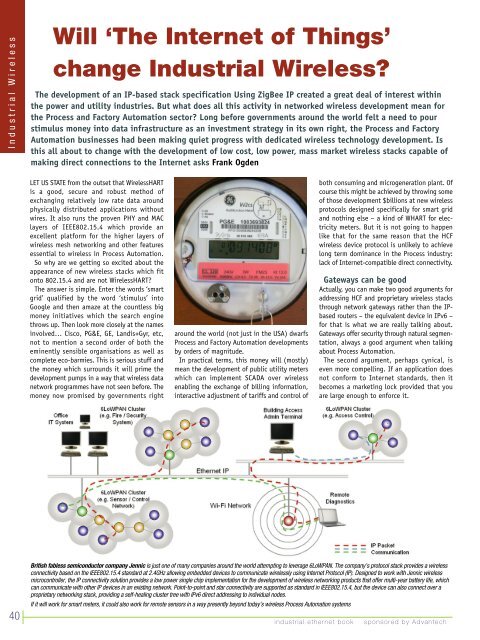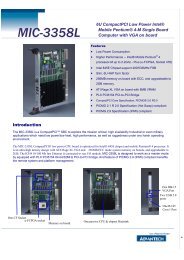industrial wireless book special edition - Networking ...
industrial wireless book special edition - Networking ...
industrial wireless book special edition - Networking ...
You also want an ePaper? Increase the reach of your titles
YUMPU automatically turns print PDFs into web optimized ePapers that Google loves.
I n d u s t r i a l W i r e l e s s<br />
Will ‘The Internet of Things’<br />
change Industrial Wireless?<br />
The development of an IP-based stack specification Using ZigBee IP created a great deal of interest within<br />
the power and utility industries. But what does all this activity in networked <strong>wireless</strong> development mean for<br />
the Process and Factory Automation sector? Long before governments around the world felt a need to pour<br />
stimulus money into data infrastructure as an investment strategy in its own right, the Process and Factory<br />
Automation businesses had been making quiet progress with dedicated <strong>wireless</strong> technology development. Is<br />
this all about to change with the development of low cost, low power, mass market <strong>wireless</strong> stacks capable of<br />
making direct connections to the Internet asks Frank Ogden<br />
LET US STATE from the outset that WirelessHART<br />
is a good, secure and robust method of<br />
exchanging relatively low rate data around<br />
physically distributed applications without<br />
wires. It also runs the proven PHY and MAC<br />
layers of IEEE802.15.4 which provide an<br />
excellent platform for the higher layers of<br />
<strong>wireless</strong> mesh networking and other features<br />
essential to <strong>wireless</strong> in Process Automation.<br />
So why are we getting so excited about the<br />
appearance of new <strong>wireless</strong> stacks which fit<br />
onto 802.15.4 and are not WirelessHART?<br />
The answer is simple. Enter the words ‘smart<br />
grid’ qualified by the word ‘stimulus’ into<br />
Google and then amaze at the countless big<br />
money initiatives which the search engine<br />
throws up. Then look more closely at the names<br />
involved… Cisco, PG&E, GE, Landis+Gyr, etc,<br />
not to mention a second order of both the<br />
eminently sensible organisations as well as<br />
complete eco-barmies. This is serious stuff and<br />
the money which surrounds it will prime the<br />
development pumps in a way that <strong>wireless</strong> data<br />
network programmes have not seen before. The<br />
money now promised by governments right<br />
around the world (not just in the USA) dwarfs<br />
Process and Factory Automation developments<br />
by orders of magnitude.<br />
In practical terms, this money will (mostly)<br />
mean the development of public utility meters<br />
which can implement SCADA over <strong>wireless</strong><br />
enabling the exchange of billing information,<br />
interactive adjustment of tariffs and control of<br />
both consuming and microgeneration plant. Of<br />
course this might be achieved by throwing some<br />
of those development $billions at new <strong>wireless</strong><br />
protocols designed specifically for smart grid<br />
and nothing else – a kind of WHART for electricity<br />
meters. But it is not going to happen<br />
like that for the same reason that the HCF<br />
<strong>wireless</strong> device protocol is unlikely to achieve<br />
long term dominance in the Process industry:<br />
lack of Internet-compatible direct connectivity.<br />
Gateways can be good<br />
Actually, you can make two good arguments for<br />
addressing HCF and proprietary <strong>wireless</strong> stacks<br />
through network gateways rather than the IPbased<br />
routers – the equivalent device in IPv6 –<br />
for that is what we are really talking about.<br />
Gateways offer security through natural segmentation,<br />
always a good argument when talking<br />
about Process Automation.<br />
The second argument, perhaps cynical, is<br />
even more compelling. If an application does<br />
not conform to Internet standards, then it<br />
becomes a marketing lock provided that you<br />
are large enough to enforce it.<br />
40<br />
British fabless semiconductor company Jennic is just one of many companies around the world attempting to leverage 6LoWPAN. The company’s protocol stack provides a <strong>wireless</strong><br />
connectivity based on the IEEE802.15.4 standard at 2.4GHz allowing embedded devices to communicate <strong>wireless</strong>ly using Internet Protocol (IP). Designed to work with Jennic <strong>wireless</strong><br />
microcontroller, the IP connectivity solution provides a low power single chip implementation for the development of <strong>wireless</strong> networking products that offer multi-year battery life, which<br />
can communicate with other IP devices in an existing network. Point-to-point and star connectivity are supported as standard in IEEE802.15.4, but the device can also connect over a<br />
proprietary networking stack, providing a self-healing cluster tree with IPv6 direct addressing to individual nodes.<br />
If it will work for smart meters, it could also work for remote sensors in a way presently beyond today’s <strong>wireless</strong> Process Automation systems<br />
<strong>industrial</strong> ethernet <strong>book</strong><br />
sponsored by Advantech

















